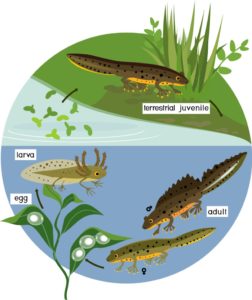Great crested newts at Earth Trust
The UK is home to three species of newt, but the largest and rarest is the great crested newt.
Looking like a dinky dinosaur, this amazing amphibian is internationally endangered and protected by law. In fact, amphibian species across the world are declining faster than any other class of animal.
Earth Trust Farm is home to one of the largest and most significant populations of great crested newts in the country – it’s the reason why Little Wittenham Wood and surrounding grasslands are designated not only a Site of Special Scientific Interest (SSSI) but also a Special Area of Conservation.
Little Wittenham Wood
Great crested newts can be found across most Earth Trust sites, but Little Wittenham Wood is home to our largest population. A series of ponds running through the middle of the wood provide an excellent habitat for amphibians, and great crested newts, smooth newts, frogs and toads, breed in these ponds each year. Although we think of newts as living in ponds they actually spend a lot of time on dry ground. In summer and autumn you’ll find them in hedgerows and boggy grassland where they can hunt for invertebrates, then they wait out the colder months snuggled up in a muddy bank, compost heap or amongst tree roots until the spring when they seek out the perfect pond for breeding. Great crested newts are very particular in their requirements and will travel up to 1 km to find the right pond, so their presence is a great indicator of a healthy water source.
Our senior ranger, Tim explains: “Our woodland work creates a lot of habitat piles of stacked brash, ideal for newts to hibernate in. To keep them safe and undisturbed, we stack timber that will be removed on ‘bearers’ which keep it off the ground and discourage newts from hibernating there so that they are not disrupted when we remove it. When this isn’t possible we remove the timber in late spring early, summer once the weather is nice and warm and the newts are back in the ponds.
“It’s amazing where they can turn up. I once found one whilst replacing the fence on the top of Round Hill, not sure why it had gone up there but we relocated it to a log pile a little closer to one of our suitable ponds.”
Last year, as part of the River of Life II project, we dug three new ponds in Little Wittenham Woods which will provide considerably more space for newts and other pondlife in the wood. Ponds are incredibly important habitats and one of the very best things you can provide in your garden for wildlife, even if it’s a very small one!
Over recent years there has been an ever-increasing interest in garden ponds and the creation of these has provided newts with much-needed habitats. This, together with legal protection, may just help our dinky dinosaurs to avoid extinction.
Why not have a go at making your own pond?
Great crested newt facts:

Mini-giants: Great crested newts are the largest of the UK’s three native species, growing up to 17cm in length (smooth newts and palmate newts are roughly half this size) and can live up to 15 years in the right environment.
Uniquely individual: They are dark brown or black in colour with a distinct ‘warty’ skin, and each great crested newt has a unique pattern of black spots on their orange underbelly, much like our fingerprint.
Fussy mums: Female newts lay one egg at a time on a specially selected piece of pond plant. She sniffs the leaf to make sure it has the right cellulose amount and then after laying one egg closes the leaf around it with her back legs and glues it shut over the egg.
Greedy youngsters: The tadpole of the great crested newt will feed on just about anything they can find, including insect larvae, frogspawn and tadpoles. As adults, they are even more voracious and will eat juvenile smooth newts, worms and beetles.